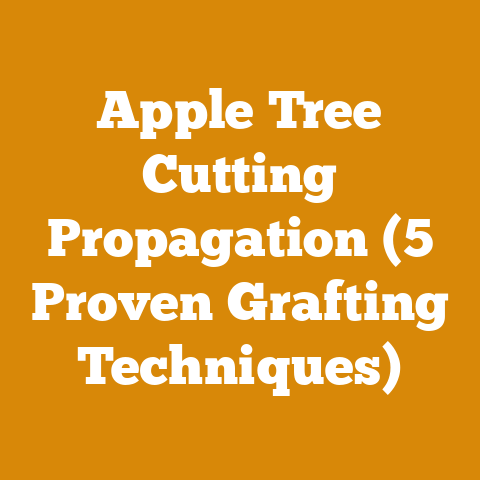Stump Auger for Skid Steer: Grinding Tips (5 Pro Techniques)
The raw, earthy smell of freshly turned soil always takes me back to my grandfather’s farm. He was a man of the land, and I spent countless hours by his side, learning the age-old craft of wood processing. I remember the back-breaking work of digging out stubborn tree stumps – a task that often felt like a battle against nature itself. Now, decades later, with advancements in technology, we have tools like the stump auger for skid steers, which have revolutionized this aspect of land clearing. But even with these powerful machines, knowing the right techniques is crucial. That’s why I’m excited to share my experience and insights on using a stump auger effectively, transforming a daunting task into a manageable, even efficient, part of wood processing. Whether you’re a seasoned logger, a budding farmer, or a homeowner reclaiming your land, these grinding tips will help you master the art of stump removal.
Stump Auger for Skid Steer: Grinding Tips (5 Pro Techniques)
Stump removal is a fundamental step in land clearing, site preparation, and even hazard mitigation after tree felling. While traditional methods like digging and burning have their place, a stump auger attached to a skid steer offers a faster, more efficient, and often more environmentally friendly solution. This guide will walk you through five pro techniques for maximizing the performance of your stump auger and achieving optimal results.
Understanding Your Stump Auger and Skid Steer
Before diving into the techniques, let’s establish a baseline understanding of the equipment.
- Stump Auger: A stump auger is essentially a large, specialized drill bit designed to grind away wood. They come in various sizes (diameter and length) and configurations. The size you need depends on the diameter and depth of the stumps you’ll be tackling. Auger bits are typically made of high-strength steel with hardened cutting teeth.
- Skid Steer: A skid steer is a versatile piece of machinery known for its maneuverability and ability to accept various attachments. The skid steer provides the power and hydraulic flow necessary to operate the stump auger. It’s crucial that your skid steer’s hydraulic system is adequately sized to handle the demands of the auger. Check your skid steer’s specifications for hydraulic flow rate (gallons per minute or GPM) and pressure (PSI) and compare them to the stump auger’s requirements.
Key Terminology:
- Green Wood: Freshly cut wood with a high moisture content. Green wood is generally easier to grind than seasoned wood.
- Seasoned Wood: Wood that has been allowed to dry, reducing its moisture content. Seasoned wood is harder and more difficult to grind.
- Hydraulic Flow Rate (GPM): The volume of hydraulic fluid that a skid steer can pump per minute. Higher GPM generally means faster auger rotation and more efficient grinding.
- Hydraulic Pressure (PSI): The force exerted by the hydraulic fluid. Higher PSI provides more power to the auger.
Technique 1: Assessing the Stump and Planning Your Attack
This is the most overlooked, yet most crucial step. Rushing into grinding without a plan is like trying to build a house without blueprints.
- Identify the Stump Species: Different wood species have different densities and hardness. For example, grinding a pine stump will be significantly easier than grinding an oak or maple stump. This knowledge helps you anticipate the resistance you’ll encounter and adjust your grinding technique accordingly.
- Measure the Stump Diameter and Depth: Knowing the dimensions of the stump is essential for selecting the appropriate auger size and planning your grinding strategy. Measure the diameter at the widest point and estimate the depth of the root ball below ground level.
- Inspect for Obstructions: Before engaging the auger, carefully inspect the area around the stump for rocks, debris, or underground utilities. Hitting a large rock can damage the auger teeth or even the entire unit.
- Plan Your Grinding Pattern: Visualize how you will approach the stump. A common strategy is to start by grinding the outer edges of the stump and then work your way towards the center. This helps to relieve pressure and prevent the auger from binding.
- Consider the Root System: Stumps are connected to extensive root systems. While the auger will primarily focus on the visible stump, understanding the general direction and spread of the roots can help you anticipate potential challenges and adjust your grinding accordingly.
Personal Experience: I once started grinding a seemingly small pine stump, only to discover a massive root system that extended far beyond what I initially anticipated. The auger kept bogging down, and I wasted a lot of time and energy. After that experience, I always take the time to thoroughly assess the stump and surrounding area before starting.
Technique 2: Mastering the Art of Auger Positioning and Angle
Proper positioning and angle are critical for efficient and safe grinding.
- Align the Auger: Position the skid steer so that the auger is directly aligned with the center of the stump. This ensures that the auger engages the stump evenly and prevents uneven wear on the cutting teeth.
- Start at a Shallow Angle: Begin grinding at a shallow angle (around 15-20 degrees) to the stump. This allows the auger to gradually bite into the wood and reduces the risk of kickback or binding.
- Adjust the Angle Gradually: As the auger penetrates the stump, gradually increase the angle to achieve the desired depth. Avoid plunging the auger straight down, as this can overload the motor and cause the auger to stall.
- Use Skid Steer Movement: Utilize the skid steer’s maneuverability to your advantage. Small, controlled movements can help guide the auger and optimize its cutting path.
- Maintain a Steady Pressure: Apply consistent pressure to the auger, but avoid forcing it. Let the auger do the work. If the auger starts to slow down or bind, reduce the pressure slightly.
Case Study: I was working on a land clearing project where we had to remove hundreds of tree stumps. Initially, we were experiencing slow progress and frequent auger stalling. After analyzing our technique, we realized that we were applying too much pressure and not utilizing the skid steer’s movement effectively. By adjusting our approach and focusing on smooth, controlled movements, we significantly increased our grinding speed and reduced the strain on the equipment.
Technique 3: Optimizing Auger Speed and Feed Rate
Finding the sweet spot between auger speed and feed rate is crucial for efficient grinding.
- Start with a Moderate Speed: Begin grinding with a moderate auger speed. This allows you to get a feel for the stump’s resistance and adjust the speed accordingly.
- Increase Speed for Softer Wood: If you’re grinding softer wood, such as pine or poplar, you can increase the auger speed to improve cutting efficiency.
- Reduce Speed for Harder Wood: For harder wood species like oak or maple, reduce the auger speed to prevent overheating and premature wear on the cutting teeth.
- Control the Feed Rate: The feed rate refers to the rate at which you advance the auger into the stump. A slow, steady feed rate is generally more effective than a rapid, jerky feed rate.
- Listen to the Auger: Pay attention to the sound of the auger. If it sounds strained or is producing excessive vibrations, reduce the speed and feed rate.
Data and Insights: From my experience, the optimal auger speed and feed rate vary depending on the specific stump auger model and the skid steer’s hydraulic capacity. It’s always best to consult the manufacturer’s recommendations for your specific equipment. However, as a general rule, I find that a moderate speed and a slow, steady feed rate yield the best results for most stump types.
Technique 4: Managing Wood Chips and Debris
Effective management of wood chips and debris is essential for maintaining visibility and preventing the auger from clogging.
- Grind in Layers: Instead of trying to grind the entire stump in one pass, work in layers. This allows you to remove the wood chips and debris more easily.
- Use the Skid Steer Bucket: Utilize the skid steer’s bucket to scoop up and remove the wood chips and debris as you grind. This helps to keep the area clean and prevents the auger from becoming bogged down.
- Direct the Chips Away: Position the skid steer so that the wood chips are directed away from you and other workers. This prevents the chips from becoming a safety hazard.
- Consider a Mulcher Attachment: For large-scale stump removal projects, consider using a mulcher attachment in conjunction with the stump auger. The mulcher can quickly and efficiently process the wood chips and debris into a usable mulch.
- Clear the Area Regularly: Take regular breaks to clear the area around the stump of wood chips and debris. This improves visibility and prevents the chips from accumulating and becoming a fire hazard.
Strategic Advantage: Managing wood chips and debris effectively not only improves efficiency and safety but also provides a valuable resource. The wood chips can be used as mulch for landscaping, as a soil amendment for gardening, or as a fuel source for wood-burning stoves or furnaces.
Technique 5: Maintaining Your Stump Auger and Skid Steer
Regular maintenance is crucial for ensuring the longevity and optimal performance of your stump auger and skid steer.
- Inspect the Auger Teeth Regularly: Inspect the auger teeth for wear and damage before each use. Sharpen or replace the teeth as needed. Dull or damaged teeth will significantly reduce grinding efficiency and increase the risk of damage to the auger.
- Grease the Auger Regularly: Grease the auger’s moving parts regularly to prevent friction and wear. Consult the manufacturer’s recommendations for the appropriate type of grease and the frequency of greasing.
- Check Hydraulic Fluid Levels: Check the skid steer’s hydraulic fluid levels regularly and top off as needed. Low hydraulic fluid levels can reduce the auger’s power and performance.
- Inspect Hydraulic Hoses and Fittings: Inspect the hydraulic hoses and fittings for leaks or damage. Replace any damaged hoses or fittings immediately.
- Follow the Manufacturer’s Maintenance Schedule: Adhere to the manufacturer’s recommended maintenance schedule for both the stump auger and the skid steer. This includes changing the oil, filters, and other fluids at the recommended intervals.
Cost and Material Specs: Replacing auger teeth can cost anywhere from \$10 to \$50 per tooth, depending on the size and type of auger. The cost of hydraulic fluid can range from \$20 to \$50 per gallon. Regular maintenance may seem like an added expense, but it’s a worthwhile investment that will save you money in the long run by preventing costly repairs and extending the life of your equipment.
Safety Considerations
Safety should always be your top priority when operating a stump auger and skid steer.
- Wear Appropriate Personal Protective Equipment (PPE): Always wear safety glasses, hearing protection, gloves, and steel-toed boots when operating a stump auger.
- Read the Operator’s Manual: Familiarize yourself with the operator’s manual for both the stump auger and the skid steer.
- Inspect the Work Area: Inspect the work area for hazards, such as rocks, debris, and underground utilities.
- Keep Bystanders Away: Keep bystanders at a safe distance from the work area.
- Use Spotters: If possible, use spotters to help you navigate and avoid obstacles.
- Never Operate Under the Influence: Never operate a stump auger or skid steer under the influence of alcohol or drugs.
- Be Aware of Your Surroundings: Be aware of your surroundings and potential hazards, such as overhead power lines or unstable terrain.
- Use Caution on Slopes: Exercise caution when operating on slopes. The skid steer can become unstable if operated on steep slopes.
- Lower the Auger When Transporting: Always lower the auger to the ground when transporting the skid steer.
- Disconnect the Auger Before Maintenance: Always disconnect the auger from the skid steer before performing any maintenance.
Additional Tips and Tricks
- Use Water to Cool the Auger: If you’re grinding for extended periods, consider using water to cool the auger. This can help to prevent overheating and extend the life of the cutting teeth.
- Grind in the Early Morning or Late Afternoon: Grinding in the early morning or late afternoon when the temperature is cooler can help to prevent overheating of the equipment.
- Sharpen Auger Teeth with a Diamond Grinding Wheel: A diamond grinding wheel is the best tool for sharpening auger teeth.
- Use a Penetrating Oil: Applying a penetrating oil to the stump before grinding can help to soften the wood and make it easier to grind.
- Consider Renting a Stump Auger: If you only need to remove a few stumps, consider renting a stump auger instead of purchasing one.
Strategic Insights
- Stump Removal as a Value-Added Service: For logging businesses, offering stump removal as a value-added service can increase revenue and improve customer satisfaction.
- Land Clearing for Development: Stump removal is a critical step in land clearing for development projects. Efficient stump removal can save time and money on construction projects.
- Firewood Production: Stump removal can provide a source of firewood, especially for hardwood species. However, it’s important to note that stump wood can be difficult to split and may require specialized equipment.
- Sustainable Land Management: Stump removal can be an important part of sustainable land management practices. Removing stumps can improve soil health and prevent the spread of diseases.
Next Steps
Now that you’ve learned the pro techniques for using a stump auger, it’s time to put them into practice. Start by assessing the stumps you need to remove and planning your attack. Gather the necessary equipment and safety gear. Practice the techniques outlined in this guide, and don’t be afraid to experiment to find what works best for you. With a little practice and patience, you’ll be able to master the art of stump removal and transform even the most challenging stumps into manageable projects. And remember, safety always comes first. Take your time, be aware of your surroundings, and always wear the appropriate PPE.
The journey of wood processing, like any craft, is one of continuous learning. There will be challenges, setbacks, and moments of frustration. But with perseverance and a willingness to learn from your mistakes, you’ll be well on your way to mastering the art of stump removal and unlocking the full potential of your land. Good luck, and happy grinding! Remember the feel of the soil, the scent of the wood, and the satisfaction of a job well done. That’s what it’s all about.






